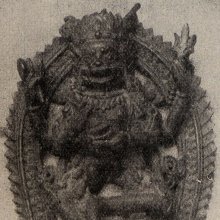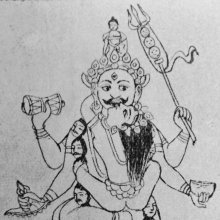Citrasena, Citrasenā: 17 definitions
Introduction:
Citrasena means something in Hinduism, Sanskrit. If you want to know the exact meaning, history, etymology or English translation of this term then check out the descriptions on this page. Add your comment or reference to a book if you want to contribute to this summary article.
Alternative spellings of this word include Chitrasena.
Images (photo gallery)
In Hinduism
Purana and Itihasa (epic history)
Source: Wisdom Library: Bhagavata PuranaCitrasena (चित्रसेन):—Son of Nariṣyanta (son of Śrāddhadeva or Vaivasvata Manu). He had a son named Ṛkṣa. (see Bhāgavata Purāṇa 9.2)
Source: archive.org: Puranic Encyclopedia1) Citrasena (चित्रसेन).—A gandharva. There is reference to this gandharva in many places in the purāṇas. He had two wives Sandhyāvalī and Ratnāvalī. How Arjuna saved him. Once when Citrasena with his wives was travelling in the aerial car the spittings of Citrasena fell upon the sage Gālava who was doing his sandhyā rites then. The sage complained about the incident to Śrī Kṛṣṇa who promised to bring to him the head of Citrasena before sun-set. Sage Nārada informed Citrasena of this vow of Kṛṣṇa. The gandharva was taken aback and did not know what to do. But Sandhyāvalī and Ratnāvalī went and sought the help of Subhadrā. They made a fire pit in front of her house and decided to end their lives along with Citrasena by jumping into the fire. While Citrasena was circling the fire-pit before jumping into it his wives wept loudly and hearing the noise Subhadrā came out and saw what was happening. They then took from Subhadrā a boon to the effect that they should be allowed to live with their husband. It was only after granting them the boon that Subhadrā understood the whole situation. Subhadrā was in a fix but Arjuna assured her that Citrasena would be protected at any cost. Arjuna very cleverly shielded all the arrows sent against the gandharva by Kṛṣṇa and gradually the fight came to be one between Arjuna and Śrī Kṛṣṇa. Subhadrā came between them and it was found difficult to continue the fight. Śrī Kṛṣṇa advised Citrasena to bow down and touch the feet of Gālava. Citrasena obeyed and the issue settled without harm to both the parties. (See full article at Story of Citrasena from the Puranic encyclopaedia by Vettam Mani)
2) Citrasena (चित्रसेन).—(ugrasena) One of the hundred sons of Dhṛtarāṣṭra. Other details.
2) Citrasena was present for the svayaṃvara of Pāñcālī. (Śloka 3, Chapter 185, Ādi Parva, Mahābhārata).
2) Citrasena was among those who accompanied Duryodhana when he went to play the historical game of dice with Dharmaputra. (Śloka 13, Chapter 58, Sabhā Parva).
2) In the great Mahābhārata battle he fought against Bhīmasena, Suśarmā, Sātyaki and Śatānīka. Bhīma killed him. (Chapter 137, Droṇa Parva).
3) Citrasena (चित्रसेन).—A prince of the Pūru line, son of Parīkṣit and grandson of Avikṣit. (Śloka 54, Chapter 94, Ādi Parva).
4) Citrasena (चित्रसेन).—A minister of Jarāsandha. He was known as Ḍiṃbhaka also. (Śloka 32, Chapter 22, Sabhā Parva).
5) Citrasena (चित्रसेन).—A king of the country of Abhisāra. He fought on the side of the Kauravas against the Pāṇḍavas and was killed by Śrutakarmā. (Śloka 14, Chapter 14, Karṇa Parva).
6) Citrasena (चित्रसेन).—(ŚRUTASENA). Brother of Suśarmā, the king of Tṛgarta. These two brothers jointly by an incessant downpour of arrows suffocated Arjuna in the battle-field. (Chapter 27, Karṇa Parva, Mahābhārata).
7) Citrasena (चित्रसेन).—A warrior of Pāñcāla. Karṇa killed him in the great battle. (Śloka 15, Chapter 48, Karṇa Parva).
8) Citrasena (चित्रसेन).—A son of Karṇa. Nakula killed him in the great battle. (Śalya Parva, Chapter 10).
9) Citrasena (चित्रसेन).—A brother of Karṇa. In the great battle Yudhāmanyu killed him. (Śloka 39, Chapter 83, Karṇa Parva).
10) Citrasena (चित्रसेन).—One of the kings on the sea-shore. Along with his son he fought on the side of the Pāṇḍavas against the Kauravas and was killed by Samudrasena. (Śloka 16, Chapter 6, Karṇa Parva)
11) Citrasena (चित्रसेन).—A serpent. This serpent joined hands with Arjuna during the Kṛṣṇārjuna battle. (Śloka 43, Chapter 87, Karṇa Parva).
12) Citrasena (चित्रसेन).—A king of the dynasty of Vaivasvatamanu. (Navama Skandha, Bhāgavata).
13) Citrasena (चित्रसेन).—A Mahārāja who obtained salvation by observing the Aṣṭamīrohiṇī Vrata. This king was a great sinner having committed such sins as Agamyāgamana (Incest), Brahmasvāpaharaṇa (stealing things belonging to Brahmins), Surāpāna (drinking) and Prāṇihiṃsā (causing injury to living beings). One day while hunting he followed a tiger and at dusk exhausted with thirst and hunger he reached the banks of the river Yamunā. It was the day of Aṣṭamīrohiṇī and many maidens were observing the Aṣṭamīrohiṇī Vrata there. Before them was a heap of rice and other eatables which was given as an offering to Kṛṣṇa and seeing the lot the King begged for something to eat and drink. The maidens replied that it was a sin to take food on that day of Vrata and then there came a change in the mind of the King and he readily agreed to observe the Aṣṭamīrohiṇī vrata and did so. Because of this when the king died, though a great sinner he was, he was taken to heaven by the servants of Viṣṇu. This story was told by Vasiṣṭha to Dilīpa to impress upon him the greatness of observing the Aṣṭamīrohiṇī Vrata. (Chapter 13, Padma Purāṇa).
14) Citrasenā (चित्रसेना).—An Apsaras. This celestial maiden was a dancer in the court of Kubera. (Śloka 10, Chapter 10, Sabhā Parva). When Arjuna went to the land of Indra this maiden gave a dance in honour of Arjuna. (Śloka 30, Chapter 43, Vana Parva).
15) Citrasenā (चित्रसेना).—A prominent river. The people of ancient Bharatā used to drink the water of this river. (Śloka 17, Chapter 9, Bhīṣma Parva)
16) Citrasenā (चित्रसेना).—A follower of Subrahmaṇya. (Śloka 14, Chapter 40, Śalya Parva, Mahābhārata).
Source: Cologne Digital Sanskrit Dictionaries: The Purana Index1a) Citrasena (चित्रसेन).—A son of Manu Devasāvarṇi.*
- * Bhāgavata-purāṇa VIII. 13. 30.
1b) The son of Nariṣyanta and father of Dakṣa.*
- * Bhāgavata-purāṇa IX. 2. 19.
1c) A Gandharva with the Hemanta sun.*
- * Brahmāṇḍa-purāṇa II. 23. 17; Vāyu-purāṇa 52. 17. 96. 248.
1d) A son of Agāvaha.*
- * Brahmāṇḍa-purāṇa III. 71. 257.
1e) A son of the fourth Sāvarṇa Manu.*
- * Brahmāṇḍa-purāṇa IV. 1. 94.
1f) A son of Ruci XIII Manu.*
- * Brahmāṇḍa-purāṇa IV. 1. 104; Vāyu-purāṇa 100. 108; Viṣṇu-purāṇa III. 2. 41.
1g) A Mauneya Gandharva king in Kailasa;1 resides in sun's chariot2 during Mārgaśīrṣa month.
Source: Archaeological Survey of India: Śaiva monuments at Paṭṭadakal (purāṇa)Citrasenā (चित्रसेना), as per the Narasiṃhapurāṇa, is the wife of Kubera. She is a devotee of Pārvatī. While she is engaged in worshipping the goddess, Indra on the way to forest for undertaking penance in order to attain mokṣa, liberation, sees Citrasenā. He forgets the aim of his journey and falls madly in love with her. He requests Kāma, God of Love to awaken desire for him in her. Cupid promptly obeys the overlord of gods. Under the effect of Kāma’s arrows Citrasenā, in love with Indra, becomes entirely his.
Source: JatLand: List of Mahabharata people and placesCitrasena (चित्रसेन) is a name mentioned in the Mahābhārata (cf. I.89.48) and represents one of the many proper names used for people and places. Note: The Mahābhārata (mentioning Citrasena) is a Sanskrit epic poem consisting of 100,000 ślokas (metrical verses) and is over 2000 years old.
Citrasenā also refers to the name of a Lady mentioned in the Mahābhārata (cf. IX.45.14).
Citrasenā also refers to the name of a River mentioned in the Mahābhārata (cf. VI.10.16, VI.10.25, VI.18.11).

The Purana (पुराण, purāṇas) refers to Sanskrit literature preserving ancient India’s vast cultural history, including historical legends, religious ceremonies, various arts and sciences. The eighteen mahapuranas total over 400,000 shlokas (metrical couplets) and date to at least several centuries BCE.
Shilpashastra (iconography)
Source: Archaeological Survey of India: Śaiva monuments at Paṭṭadakal (śilpa)Citrasenā (चित्रसेना) is depicted as a sculpture on the first pillar of the southern half of the maṇḍapa of the temple of Trailokyeśvara.—In the superior panel, to the extreme left is a lady sitting in front of an edifice which looks like a temple. The lady may be identified with Citrasenā. She looks worried. There is a man with an umbrella. Probably he is Indra. He is shown with an umbrella or he is holding an umbrella to the noble lady to enamour her.

Shilpashastra (शिल्पशास्त्र, śilpaśāstra) represents the ancient Indian science (shastra) of creative arts (shilpa) such as sculpture, iconography and painting. Closely related to Vastushastra (architecture), they often share the same literature.
Shaktism (Shakta philosophy)
Source: Kamakoti Mandali: The Yoginis of Narasimha VyuhaCitrasenā (चित्रसेना) is the name of a Mātṛkā-Śakti created by Mahārudra in order to control the plague of demons created by Andhakāsura.—Accordingly, Andhaka-Asura tried to kidnap Umā (Devī Pārvatī), and was fiercely attacked by Mahārudra who shot arrows at him from his mahāpināka. when the arrows pierced the body of Andhakāsura, drops of blood fell to earth and from those drops, thousands of Andhakas arose. To control this plague of demons, Mahārudra created Mātṛkā-Śaktis [viz., Citrasenā] and ordered them to drink the blood of the demons and drain them dry.
Source: Kamakoti Mandali: Nrisimha matrika-mandalaCitrasenā (चित्रसेना) refers to one of the various Mātṛkā-Śaktis created by Rudra in order to destroy the clones that spawned from Andhaka’s body.—Accordingly, [...] Andhakāsura attempted to abduct Girājanandinī (Pārvatī) and thus ensued a fierce battle between Andhakāsura and the great Rudra, the Lord of Umā. Like raktabīja, every drop of blood that fell from the body of Andhaka created another Asura like him and in no time, the entire world was filled with Andhakas. To destroy the growing number of Andhakas, Rudra created innumerable Mātṛkā-Śaktis [viz., Citrasenā]. These Śaktis of immense power at once began to drink every drop of blood that flowed from the body of Andhaka, but they could still not effectively contain the emergence of more and more demons.

Shakta (शाक्त, śākta) or Shaktism (śāktism) represents a tradition of Hinduism where the Goddess (Devi) is revered and worshipped. Shakta literature includes a range of scriptures, including various Agamas and Tantras, although its roots may be traced back to the Vedas.
General definition (in Hinduism)
Source: Apam Napat: Indian MythologyChitrasena, is a Gandharva, the son of \enity
Source: WikiPedia: HinduismCitrasena (चित्रसेन): King of the Gandharvas who prevented the Kauravas from putting up their camp near the pond where he himself had encamped.
Languages of India and abroad
Sanskrit dictionary
Source: Cologne Digital Sanskrit Dictionaries: Edgerton Buddhist Hybrid Sanskrit DictionaryCitrasena (चित्रसेन).—name of a yakṣa: Mahā-Māyūrī 99.
--- OR ---
Citrasenā (चित्रसेना).—name of a goddess: Sādhanamālā 502.2.
Source: Cologne Digital Sanskrit Dictionaries: Shabda-Sagara Sanskrit-English DictionaryCitrasena (चित्रसेन).—m.
(-naḥ) One of the judges or recorders of hell. E. citra, senā an army. dhṛtarāṣṭraputrabhede, gandharvabhede ca .
Source: Cologne Digital Sanskrit Dictionaries: Cappeller Sanskrit-English DictionaryCitrasena (चित्रसेन).—[adjective] furnished with brilliant weapons; [masculine] [Name] of a serpent-demon, a Gandharva, & [several] men.
Source: Cologne Digital Sanskrit Dictionaries: Monier-Williams Sanskrit-English Dictionary1) Citrasena (चित्रसेन):—[=citra-sena] [from citra > cit] mfn. (tra-) having a bright spear, [vi, 75, 9]
2) [v.s. ...] m. Name of a snake-demon, [Kauśika-sūtra 74]
3) [v.s. ...] of a leader of the Gandharvas (son of Viśvā-vasu), [Mahābhārata; Harivaṃśa 7224]
4) [v.s. ...] of a son (of Dhṛta-rāṣṭra, [Mahābhārata i, v, viii]; of Parikṣit, [i, 3743]; of Śambara, [Harivaṃśa 9251 and 9280]; of Nariṣyanta, [Bhāgavata-purāṇa ix, 2, 19]; of the 13th Manu, [Harivaṃśa 889; Bhāgavata-purāṇa viii, 13, 31]; of Gada or Kṛṣṇa, [Harivaṃśa 9194])
5) [v.s. ...] of an adversary of Kṛṣṇa, 5059
6) [v.s. ...] of Tarā-sandha’s general (Ḍimbhaka), [Mahābhārata ii, 885 f.]
7) [v.s. ...] of a divine recorder of the deeds of men, [Ācāranirṇaya]
8) [v.s. ...] (= -gupta) the secretary of a man of rank, [Horace H. Wilson]
9) [v.s. ...] Name of a scholiast on Piṅgala’s work on metres
10) Citrasenā (चित्रसेना):—[=citra-senā] [from citra-sena > citra > cit] f. Name of an Apsaras, [Mahābhārata; Harivaṃśa 12691]
11) [v.s. ...] of one of the mothers in Skanda’s retinue, [Mahābhārata ix, 2632]
12) [v.s. ...] of a courtesan, [Vātsyāyana ii, 7, 30]
13) [v.s. ...] of a river, [Mahābhārata vi, 325] (cf. caitraseni.)
Source: Cologne Digital Sanskrit Dictionaries: Yates Sanskrit-English DictionaryCitrasena (चित्रसेन):—[citra-sena] (naḥ) 1. m. A judge in hell.
[Sanskrit to German]
Sanskrit, also spelled संस्कृतम् (saṃskṛtam), is an ancient language of India commonly seen as the grandmother of the Indo-European language family (even English!). Closely allied with Prakrit and Pali, Sanskrit is more exhaustive in both grammar and terms and has the most extensive collection of literature in the world, greatly surpassing its sister-languages Greek and Latin.
See also (Relevant definitions)
Partial matches: Citra, Sena, Cena.
Starts with: Citrasena bhatta.
Full-text (+35): Caitraseni, Indrasena, Vasumaticitrasenavilasa, Narishyanta, Citravara, Midhvan, Avagaha, Citrasena bhatta, Citravati, Devasavarni, Citracampu, Kedara bhatta, Rikshashringa, Sumalini, Yudhamanyu, Kapota, Durjaya, Kapalini, Bhima, Riksha.
Relevant text
Search found 22 books and stories containing Citrasena, Citra-sena, Citra-senā, Citrasenā; (plurals include: Citrasenas, senas, senās, Citrasenās). You can also click to the full overview containing English textual excerpts. Below are direct links for the most relevant articles:
List of Mahabharata people and places (by Laxman Burdak)
The Indian Buddhist Iconography (by Benoytosh Bhattachacharyya)
Puranic encyclopaedia (by Vettam Mani)
Mahabharata (English) (by Kisari Mohan Ganguli)
Section CCXXXIX < [Ghosha-yatra Parva]
Section XLIV < [Indralokagamana Parva]
Section CLXVIII < [Ghatotkacha-badha Parva]
The Skanda Purana (by G. V. Tagare)
Chapter 53 - Ṛkṣaśṛṅga Goes to Svarga < [Section 3 - Revā-khaṇḍa]
Chapter 54 - Dīrghatapas Goes to Heaven < [Section 3 - Revā-khaṇḍa]
Chapter 55 - Kāśīrāja Attains Mokṣa < [Section 3 - Revā-khaṇḍa]
Rig Veda (translation and commentary) (by H. H. Wilson)
Rig Veda 6.75.9 < [Sukta 75]


